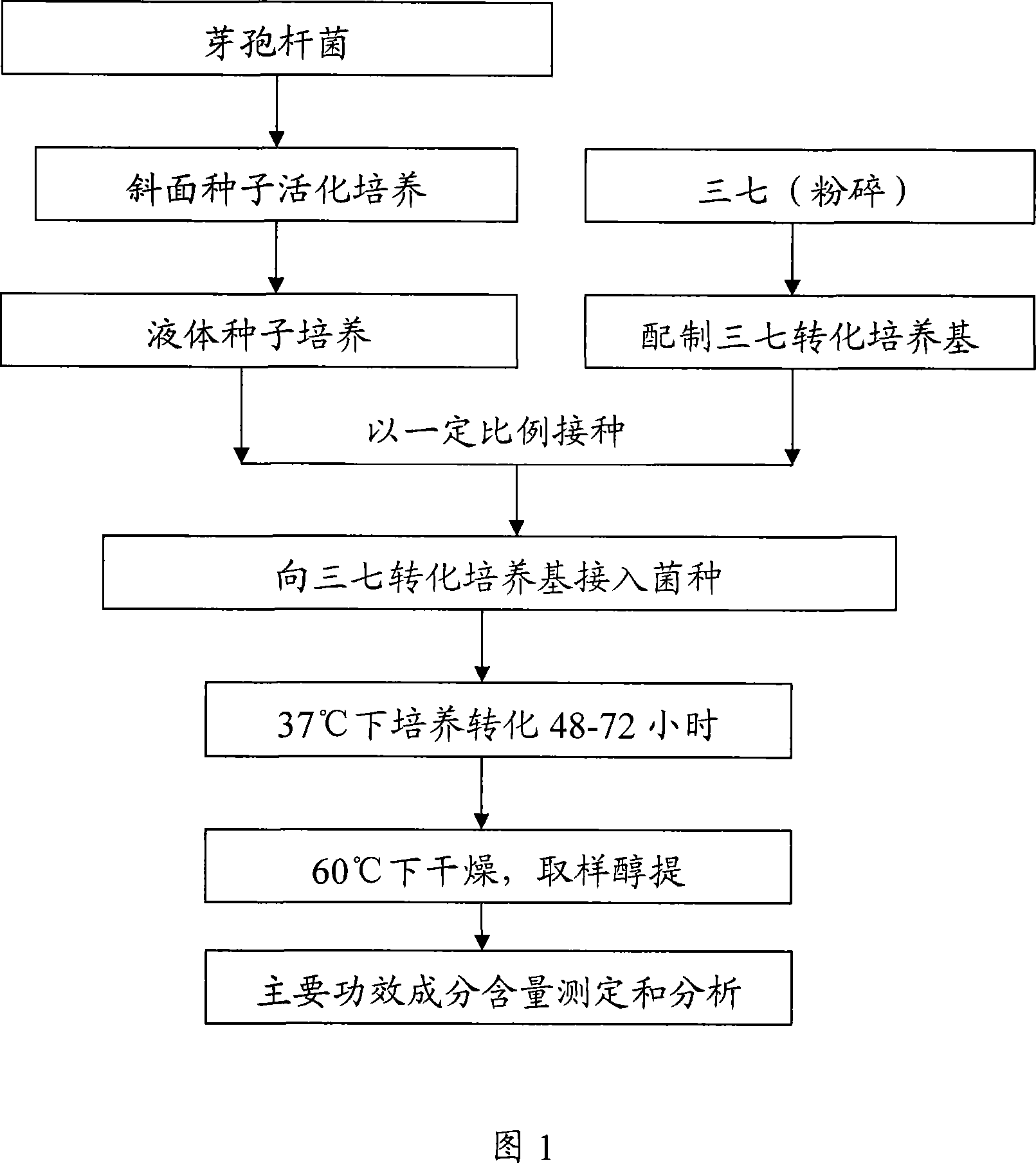Method for improving the main efficacy composition of panax notoginseng through zymolysis
A technology of Panax notoginseng and efficacy, applied in the field of bioengineering, can solve problems such as toxicity and underutilization, and achieve the effects of simple operation process, easy biotransformation, and easy culture.
- Summary
- Abstract
- Description
- Claims
- Application Information
AI Technical Summary
Problems solved by technology
Method used
Image
Examples
Embodiment 1
[0025] Example 1 Transformation effect test of different strains on Panax notoginseng leaves
[0026] Refer to the flow chart of Figure 1, using Bacillus licheniformis, Bacillus subtilis and Bacillus natto as the strains to transform the leaves of Panax notoginseng respectively, and the total saponins content of the transformed Panax notoginseng leaves are determined and extracted. The conditions and The results are as follows:
[0027] Each strain was stored on a slant in the LB medium, activated at 37°C for 24 hours, and then inoculated on the liquid seed medium. The liquid seed culture medium is LB, no agar, pH 7, and the liquid seed culture is 25-30 ml in a 250 ml shake bottle, the fermentation temperature is 37°C, the shaker speed is 180-200r / min, and the culture is obtained for 12-24 hours. liquid.
[0028] Panax notoginseng leaves were crushed by adding 2ml of distilled water per gram of Panax notoginseng and sterilized at 115°C for 15 minutes to obtain Panax notoginseng tr...
Embodiment 2
[0033] Example 2 Transformation effect test of different strains on Panax notoginseng roots
[0034] According to the method of Example 1, the root of Panax notoginseng was used as the transformation object, and the total saponins content of the transformed Panax notoginseng leaves were measured and extracted. The results are shown in Table 2.
[0035] Table 2 Effects of transformation of different strains on the content and extraction rate of total saponins of Panax notoginseng roots
[0036]
[0037] Bacillus subtilis
[0038] The control group in Table 2 is the untransformed Panax notoginseng roots. It can be seen that the total saponins content of Panax notoginseng roots can be significantly increased through biological fermentation transformation. Among them, the transformation ability of Bacillus licheniformis is the most significant, and the total saponins content reaches 5.9 mg / ml. . Compared with the control group, the total saponins content of the thr...
Embodiment 3
[0039] Example 3 Transformation effect test of Panax notoginseng leaves with different transformation times
[0040] According to the method of Example 1, only Bacillus subtilis was used as the strain, and the leaves of Panax notoginseng were used for transformation. The total saponin content of Panax notoginseng leaves after different times of transformation was measured and extracted. The results are shown in Table 3.
[0041] Table 3 Effects of different transformation times on the content and extraction rate of total saponins in Panax notoginseng leaves
[0042]
[0043] The comparative analysis in Table 3 found that different conversion times can significantly affect the content of total saponins of Panax notoginseng roots. Among them, the 72-hour conversion has the most significant impact on the total saponins content and the extraction rate of total saponins, while the change after 72 hours is not very large. .
PUM
 Login to View More
Login to View More Abstract
Description
Claims
Application Information
 Login to View More
Login to View More - R&D
- Intellectual Property
- Life Sciences
- Materials
- Tech Scout
- Unparalleled Data Quality
- Higher Quality Content
- 60% Fewer Hallucinations
Browse by: Latest US Patents, China's latest patents, Technical Efficacy Thesaurus, Application Domain, Technology Topic, Popular Technical Reports.
© 2025 PatSnap. All rights reserved.Legal|Privacy policy|Modern Slavery Act Transparency Statement|Sitemap|About US| Contact US: help@patsnap.com

